|
Packard Plant Pictures and Photos
1944 Packard Annual Report
The Packard Motor Car Company in World War Two
Detroit, MI
1899-1958
Rest in Peace
This page updated 12-30-2024.
During the Second World War
Packard built both marine and aircraft engines in its huge plant on East
Grand Boulevard in Detroit. It was a legacy of its World War One job of
building the famous Liberty engine. During World War Two, Packard
introduced American mass production techniques for the manufacture of the British Rolls-Royce
V-1650 Merlin
inline aircraft engine. Rolls-Royce-built engines were hand built
and parts hand fitted, making each one different and the parts not
interchangeable. Packard used the techniques the US auto industry
had been using for years, which consisted of interchangeable, standardized components
to start producing the
engines that were desperately needed for the US war effort. These
went into the P-40, P-51, Lancaster, Mosquito, Spitfire, and Hurricane
aircraft.
The other engine Packard built was for marine purposes, of which three
of them went into the famous American PT boats built by Elco, Higgins,
and Huckins. The engines were also used in British-designed Motor
Torpedo Boats and Motor Gun Boats. In the United States, 85-foot
and 104-foot US Army and Navy Rescue boats were also
built using the Packard 4M-2500 engine.
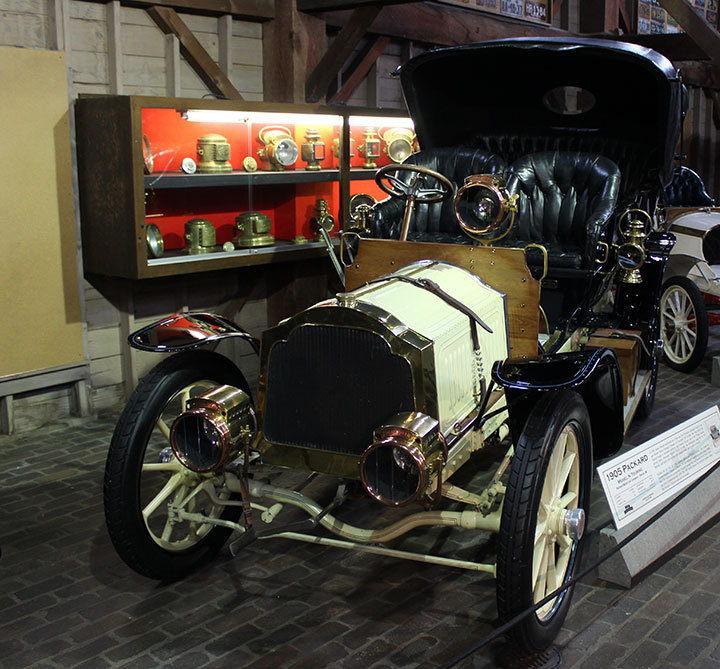
This 1905 Packard Model N Touring car is on
display at the Gilmore Car Museum in Michigan. The Packard
Brothers started building cars in 1900. Prior to building
automobiles, the Packard Brothers started the
Packard Electric Company in Warren, OH, which later became a division of
General Motors. Author's photo.
World War One:
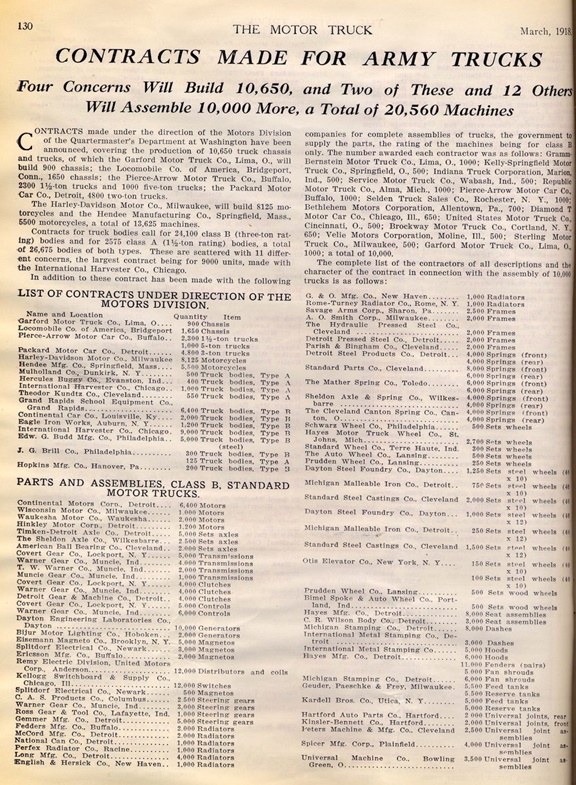
The Packard Motor Car Company was contracted
for 4,800 three-ton trucks during World War One. Document courtesy
of Warren Richardson added 6-24-2021.
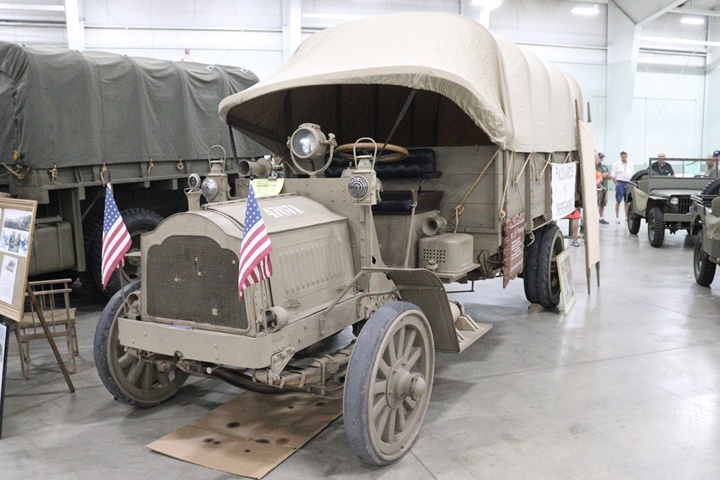
This Packard-built
three-ton truck was on display at the 2019 MVPA convention.
Author's photo from the added 6-24-2021.
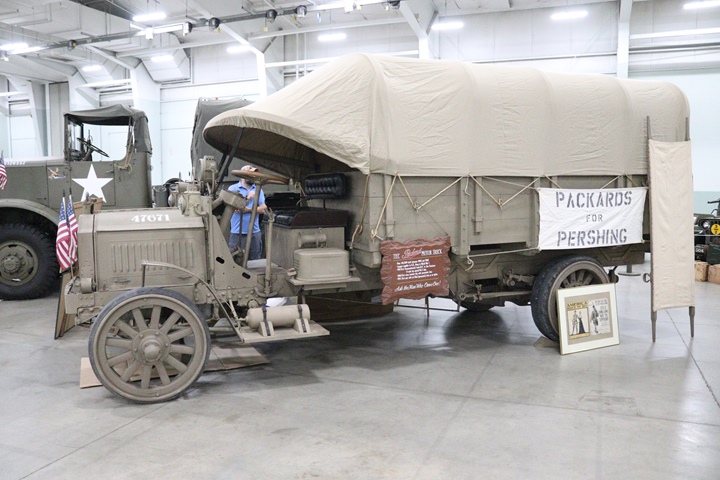
Author's photo from the
added 6-24-2021.
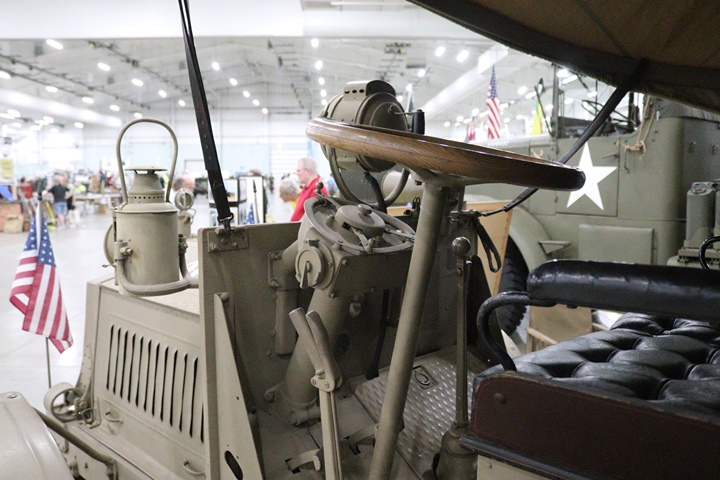
Author's photo from the
added 6-24-2021.
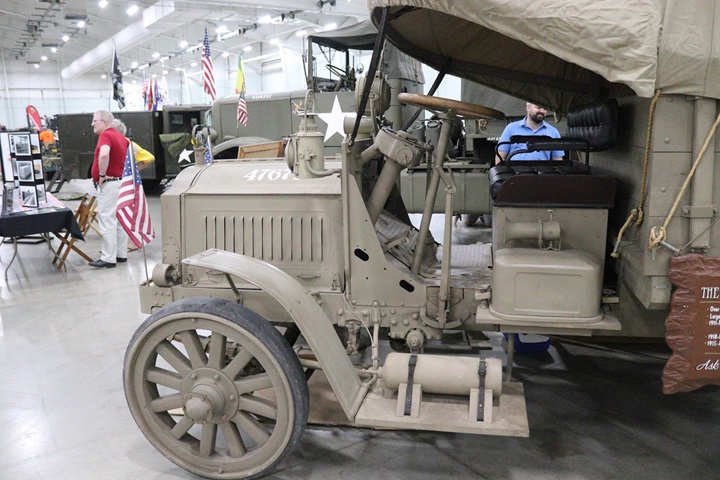
Author's photo from the
added 6-24-2021.
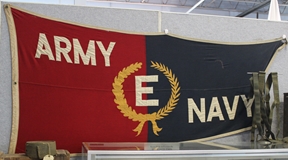
The Packard Marine Engine Division won the
Army-Navy "E" Award four times during World War Two.
Packard Motor Car Company World War Two Products: The
company had $1,722,612,000 in major contracts during World War Two.
This amount paid for 12,700 4M-2500 marine engines and 54,714 V-1650 Packard Rolls-Royce
aircraft engines. Included in the $1,722,612,000 were also
contracts for engine spare parts, training services, tools, machinery
parts, aluminum conduit, overhaul tools, spark plugs, crankshafts,
airplane magneto assemblies, electrical generator sets, oil filters,
thermostats, gears, cartridge cases, automobile parts, truck parts,
instrument panels, automobiles, castings, forgings, and superchargers.
Packard also built at least 4,597 Snow and Petrelli Mfg. Co. reversing gears for PT and rescue boats.
Snow and Petrelli Mfg. Co. was located in New Haven, CT. The
company manufactured a product line of reversing and reduction gears called
Joe's Gears. It may be that the Snow and Petrelli Mfg. Co.
was not able to keep up with the high demand for the reversing gears and
Packard took over the work under license. I have found two Packard-built
Snow and Petrelli Mfg. Co. reversing gears on Packard 4M2500 engines,
as shown in the Marine Engine section of this page. The highest of the two serial numbers on
the Packard data plate is 4597. Assuming production started with
serial number 0001, Packard built at least 4,597 of these gear boxes.
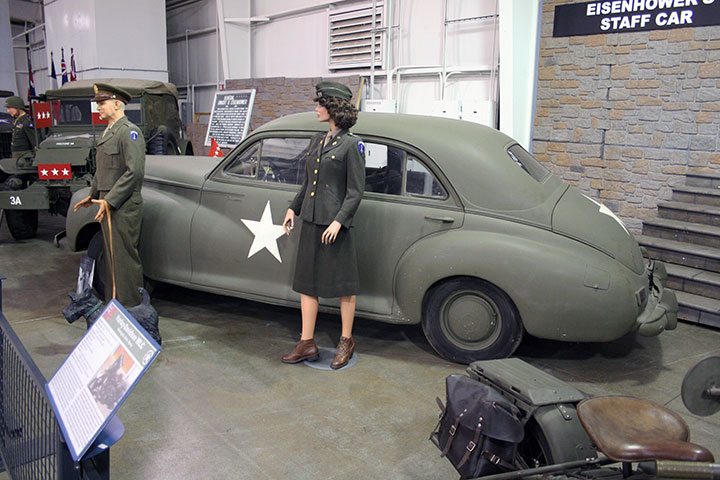
This 1942 Packard was built before the
government ended production of automobiles in February 1942. Author's Photo.
The Packard-built Merlin V-1650 Aircraft
Engine:
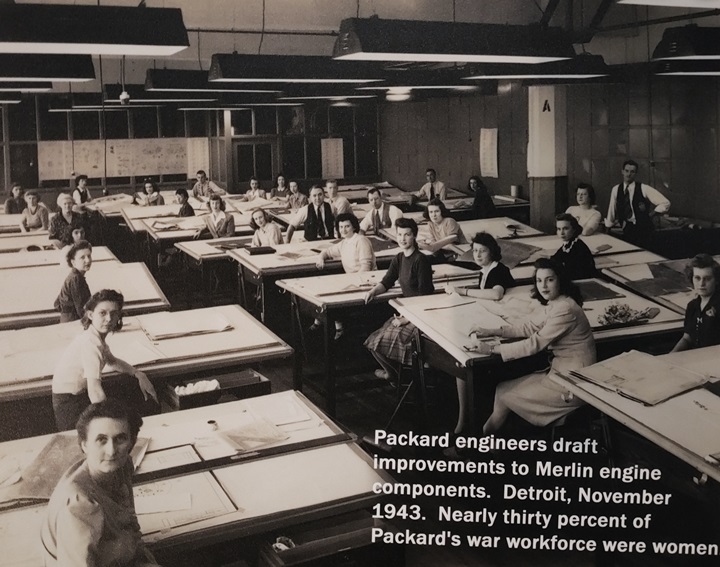
How cool is this? Women in the World
War Two work force are normally depicted as working on aircraft
production lines or as welders in shipyards. However, this image
shows that women were also used in the engineering departments. In
this case, Packard had at least 20 women working on the drafting boards
for the Merlin engines. This is out of 25 persons in the
department. Image added 12-30-2024.
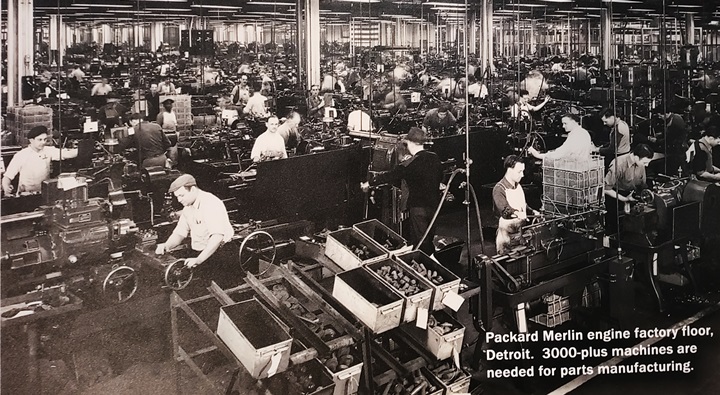
The Merlin engine was the sum of many
individual, machined components. Image added 12-30-2024.
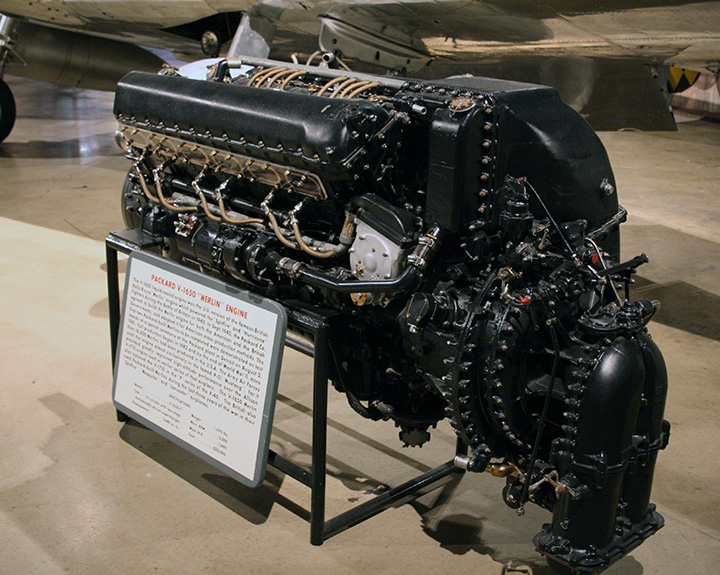
One of 54,714 Packard-built Rolls-Royce
Merlin Engines is on display at the Air Force Museum in Dayton, OH.
The success of the Merlin was because of its high altitude performance
that resulted from the super charger that can be seen here at the rear
of the engine. Author's photo.
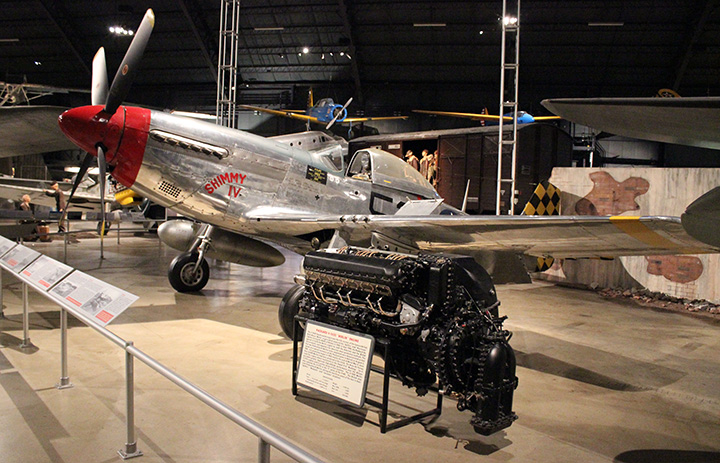
This photo shows the Packard-built Merlin on
display next to its most famous American application, the North American
P-51 Mustang. Author's photo at the National Museum of the United
States Air Force.
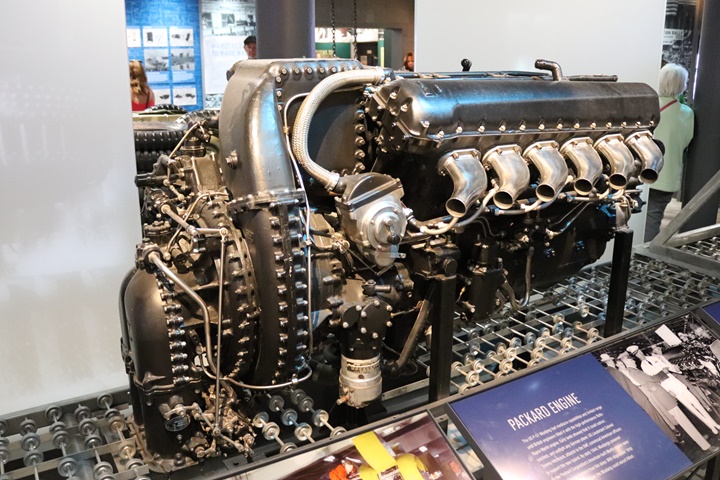
This excellent restoration of a Packard-built
Merlin is part of the "Arsenal of Democracy" display at the National
World War Two Museum in New Orleans, LA. Author's photo added
2-16-2020.
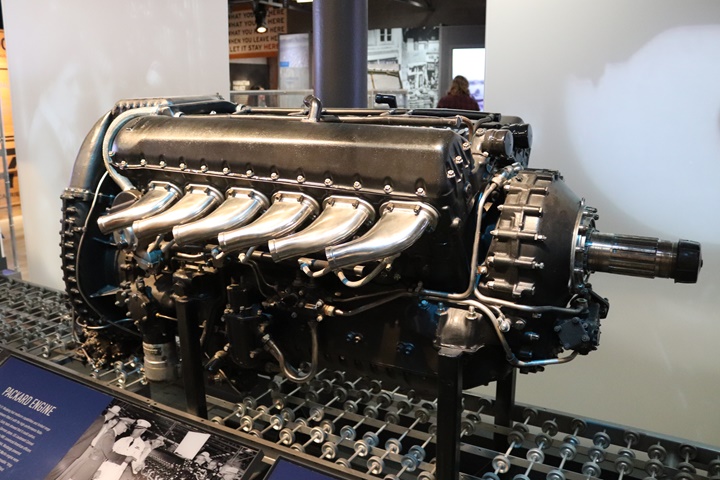
Author's photo added 2-16-2020.
|
Packard World War Two
Merlin Aircraft
Engine Production
Unfortunately I have not been able to obtain the numbers of each
type of Merlin built by Packard. One can see that the Packard
built Merlin engine went into several of the Commonwealth aircraft
besides the American Mustang. |
| Packard
Designation |
RR
Equivalent |
Application |
Comments |
| Merlin 28 |
Merlin XX
|
Lancaster
III, Canadian Lancaster X |
R.M. 3 S.M.
Single Stage 2 Speed Blower |
| Merlin 29 |
Merlin XX |
Canadian
Hurricane |
|
| Merlin 31 |
Merlin 21 |
Canadian
Mosquito |
Reversed
Coolant Flow |
| Merlin 33 |
Merlin 23 |
Canadian
and Australian Mosquito |
|
| Merlin 38 |
Merlin 22 |
Lancaster
III, Canadian Lancaster X |
|
|
Merlin T38 |
Merlin 22 |
Lancaster III, Canadian Lancaster X |
Modified Packard 38 |
| Merlin 68 |
Merlin 85 |
Lincoln II |
R.M. 10
S.M. Two Stage 2 Speed Blower Merlin 67 which was similar to the
V-1650-7 |
| Merlin 69 |
Merlin 67 |
Canadian
and Australian Mosquito |
|
| Merlin 224 |
Merlin 24 |
Lancaster
III, Canadian Lancaster X |
R.M. 3 S.M.
Single Stage 2 Speed Blower |
| Merlin 225 |
Merlin 25 |
Canadian
and Australian Mosquito |
|
| Merlin
266-P |
Merlin 66 |
Spitfire16LF |
R.M. 10
S.M. Two Stage 2 Speed Blower |
| Merlin 300 |
Merlin 100 |
Lincoln |
R.M. 14
S.M. |
| Merlin 301 |
Merlin 100 |
Lincoln |
R.M. 14
S.M. Reversed Coolant Flow |
| V-1650-1 |
Merlin XX |
P-40F
Warhawk |
Single
Stage 2 Speed Blower |
| V-1650-3 |
Merlin 61 |
P-51B/C,
CA-17 MK 20 Mustang |
Also served
as replacement for P-51D and V-1650-7 |
| V-1650-5 |
|
P-63
Kingcobra |
Not
produced. (Now this would have been on high performing
aircraft!!) |
| V-1650-7 |
|
P-51D/K,
CA-18 MK 21 Mustang |
R.M. 10
S.M. |
| V-1650-9 |
|
P-51H |
R.M. 16
S.M. |
| V-1650-9A |
|
P-51M(1),
P-51D |
R.M. 16
S.M. Also served as replacement for P-51D and V-1650-7 |
| V-1650-11 |
|
P-51L
(Cancelled), XP-82 |
R.M. 16
S.M. |
| V-1650-13 |
|
|
Not
produced. Modification of V-1650-3 to use Simmonds boost
control. |
| V-1650-15 |
|
|
Not
produced. Modification of V-1650-3 to use Simmonds boost
control. |
| V-1650-17 |
|
|
Not
produced. Modification of V-1650-3 to use Simmonds boost
control. |
| V-1650-19 |
|
|
Not
produced. |
| V-1650-21 |
|
XP-82 |
Same as
V-1650-11 but with left hand prop rotation |
| V-1650-23 |
|
P-82B/C/D |
Same as
V-1650-11 |
| V-1650-25 |
|
|
Same as
V-1650-23 but with left hand prop rotation. |
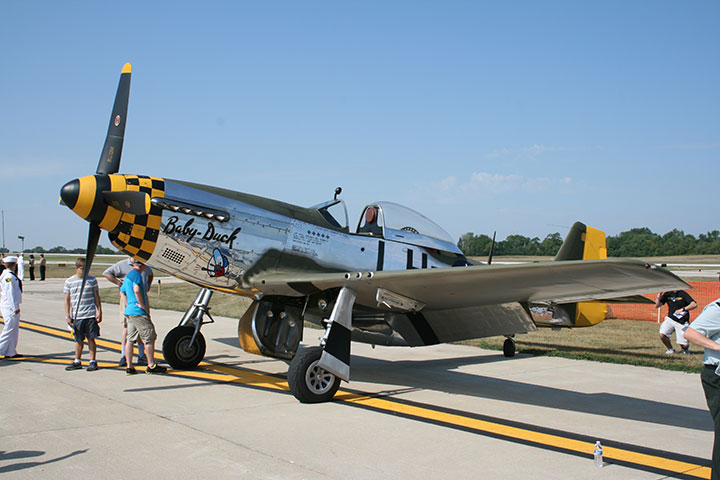
This P-51 Mustang was built with the Packard built
Merlin engine. The mating of the Merlin engine to the Mustang
airframe produced what is considered to be the best US Army Air Force
fighter of World War Two. Author's Photo.
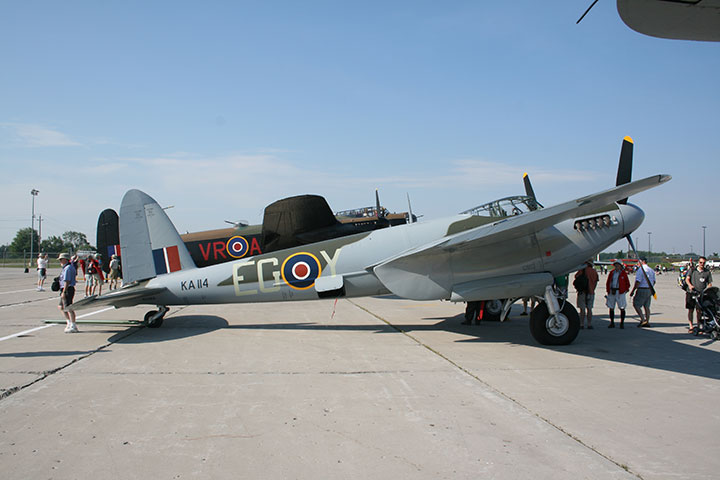
This particular De Havilland Mosquito was
built in Canada during World War Two
and would have been
equipped with the Packard-built Merlins. As in interesting side
note, the all wooden fuselages for the 1,032 Canadian-built Mosquitoes
were built by GM of Canada. Author's Photo.
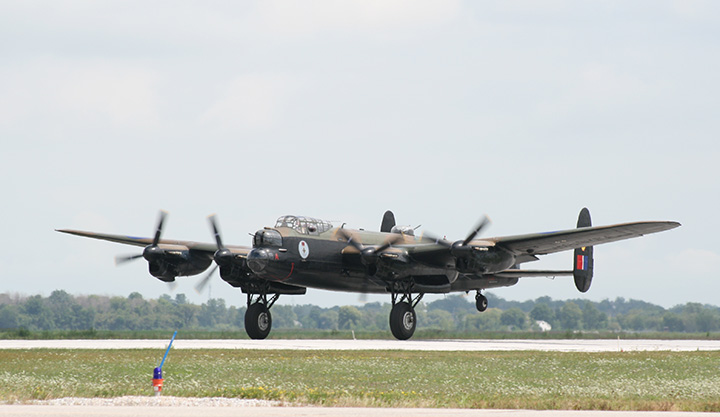
Another application of the Packard
Rolls-Merlin V-1650 was the British Lancaster bomber. Here, the
bomber's Merlins power it down the runway at Windsor, Ontario in 2010. This is
one of only two Lancasters in the world still flying. Author's
Photo.
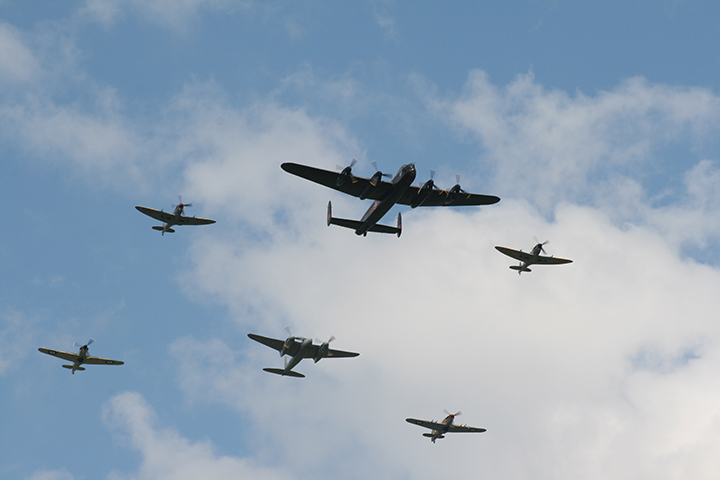
This once in a lifetime fly-over at
Hamilton, Ontario in June of 2013 has all of the aircraft powered by
Rolls-Royce V-1650 Merlin engines, most probably being the Packard-built
version. Author's Photo.
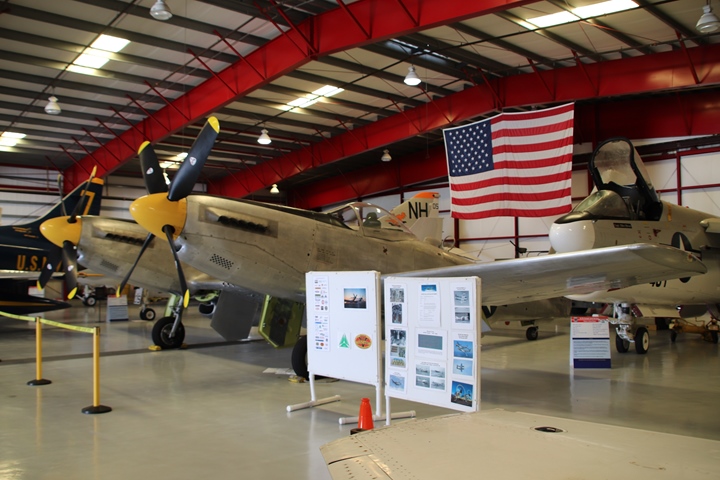
This is the North American XP-82 which is on
display at the Valiant Air Museum in Titusville, FL. This protype
aircraft was equipped with Packard-built V-1650-23/25 engines.
Author's photo added 7-26-2021.
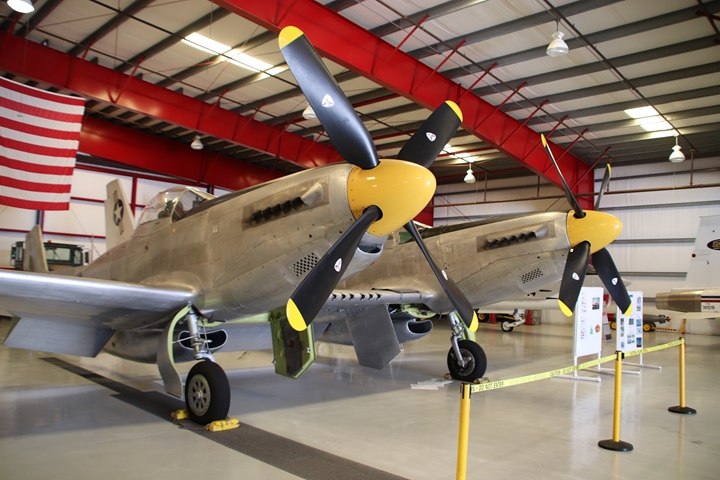
Author's photo added 7-26-2021.
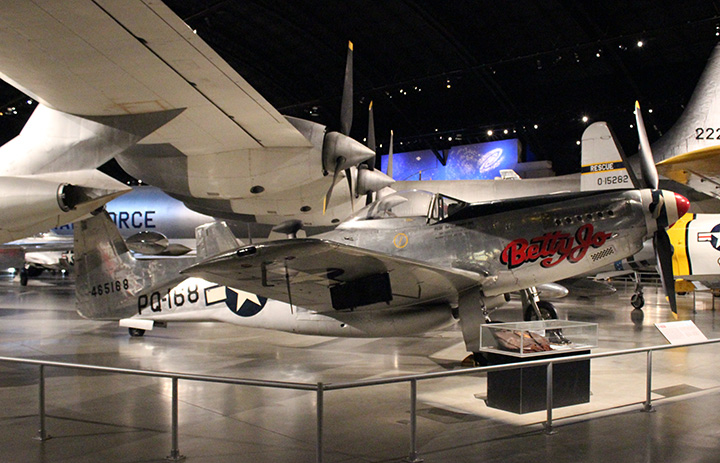
This North American P-82B was one of 20
P-82Bs produced late in World War Two as long range escort fighters that
were equipped with Packard-built V-1650-11 engines. From this angle,
the aircraft looks like a P-51. Author's photo at the National
Museum of the United States Air Force.
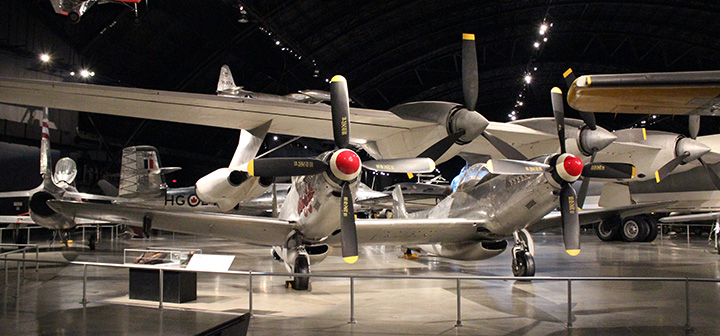
From this angle, it can be seen that there
are actually two fuselages to the P-82B. While looking like P-51
fuselages, they were actually a new and larger design. Author's photo at the
National Museum of the United States Air Force.
The Packard 4M2500 Marine Engine:
Packard built 12,700 4M2500 marine engines during World War Two.
There are still quite of few examples of this engine on display in military
museums in the United States. The best display of the 4M2500 is a
cut-a-way at the National Museum of World War Two in New Orleans, LA.
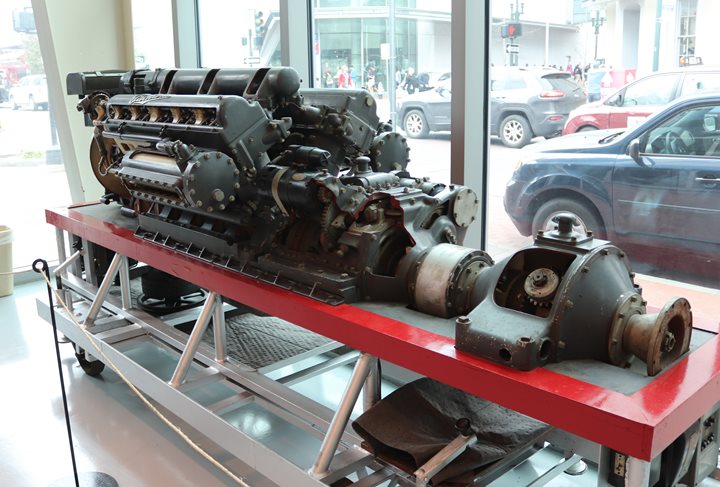
Author's photo added 4-22-2020.
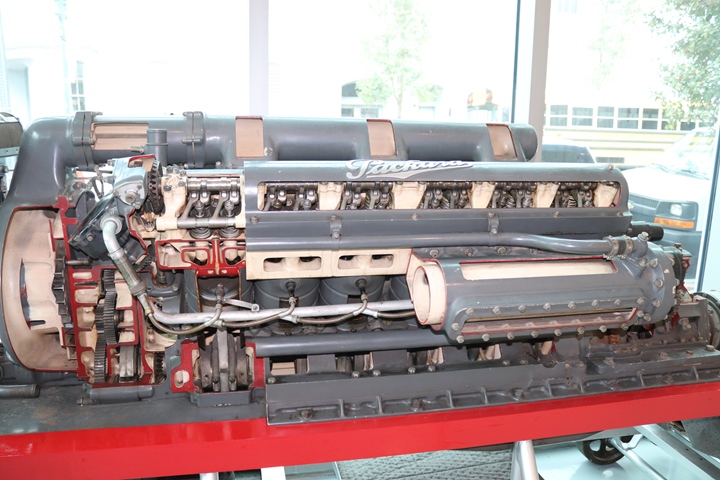
Author's photo added 4-22-2020.
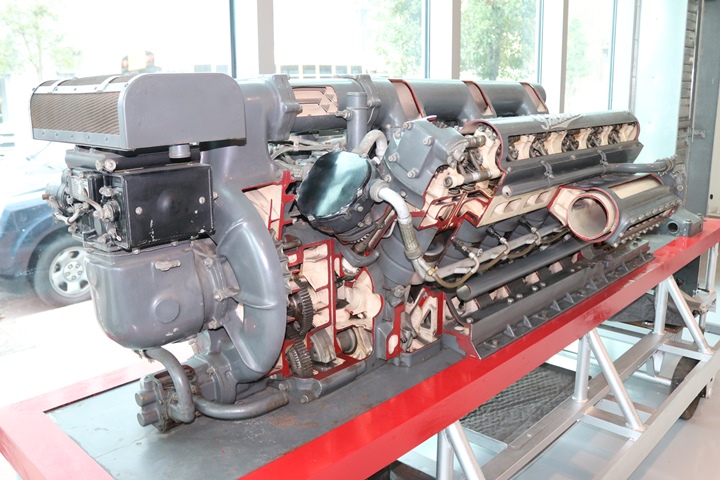
Author's photo added 4-22-2020.
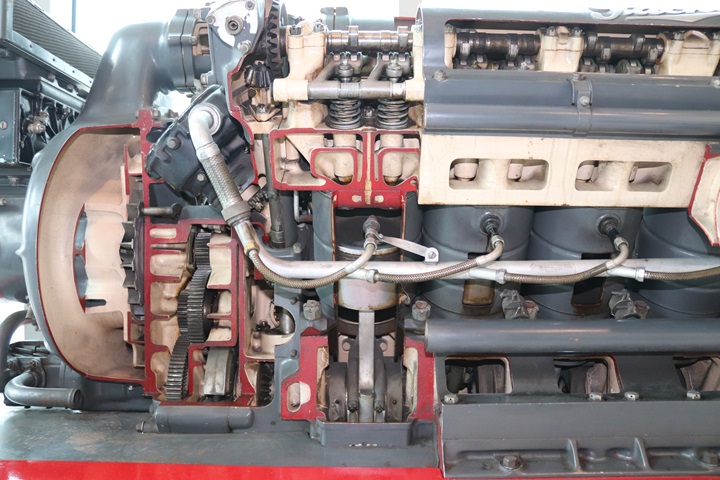
Author's photo added 4-22-2020.
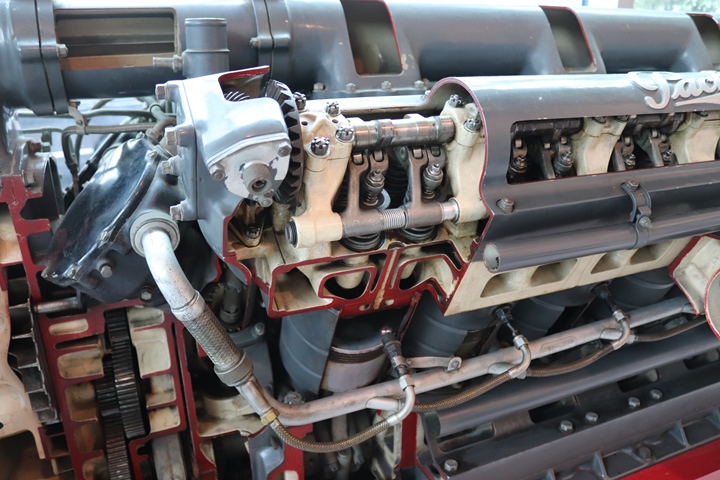
Author's photo added 4-22-2020.
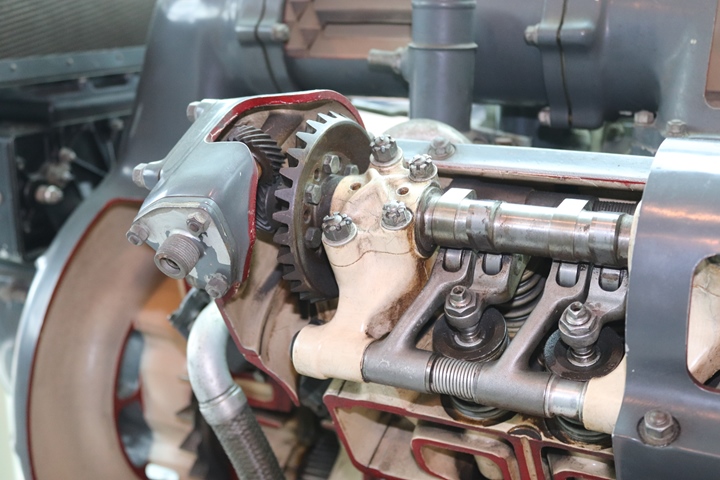
Author's photo added 4-22-2020.
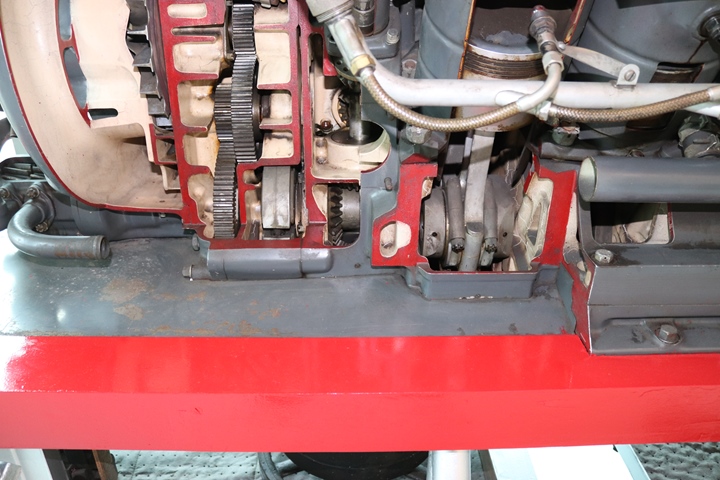
Author's photo added 4-22-2020.
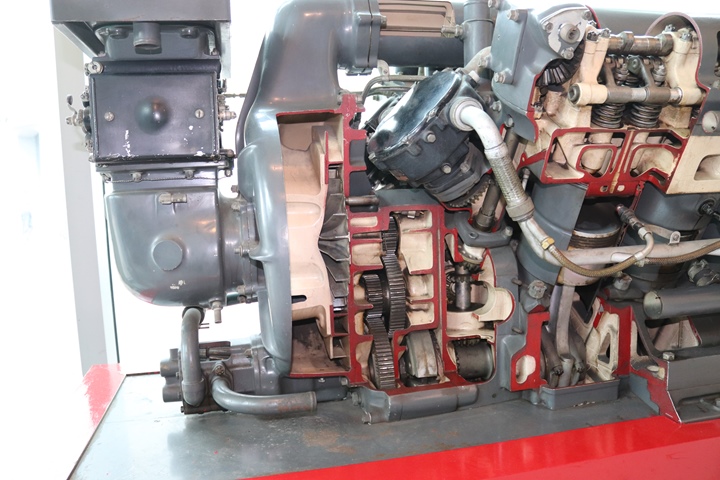
Author's photo added 4-22-2020.
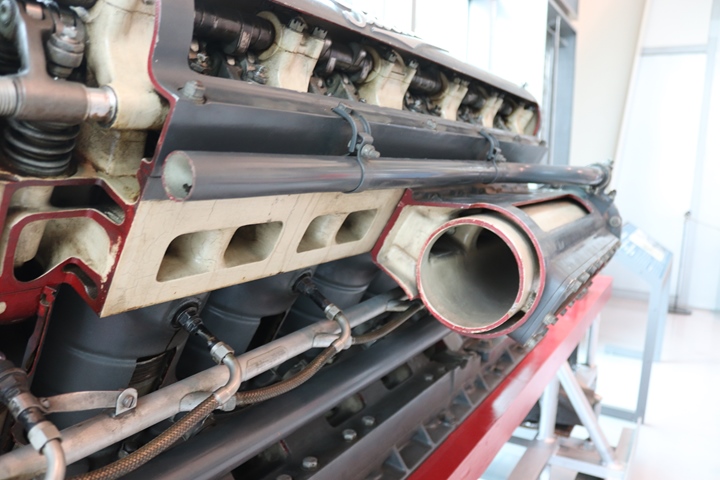
Author's photo added 4-22-2020.
Other examples can be found at the museums
below.
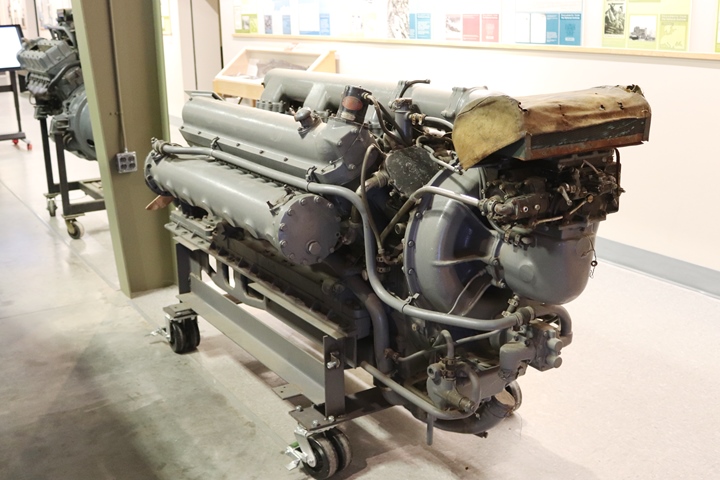
This example is on display at the Wright
Museum of World War Two in Wolfeboro, NH. Author's photo added
4-22-2020.
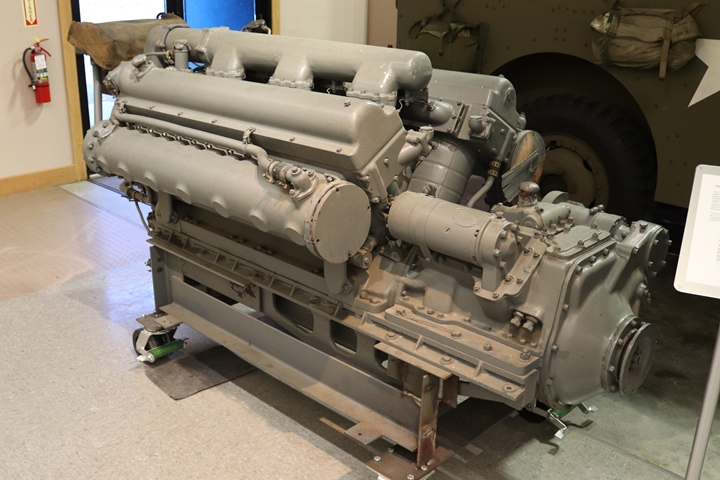
Author's photo added 4-22-2020.
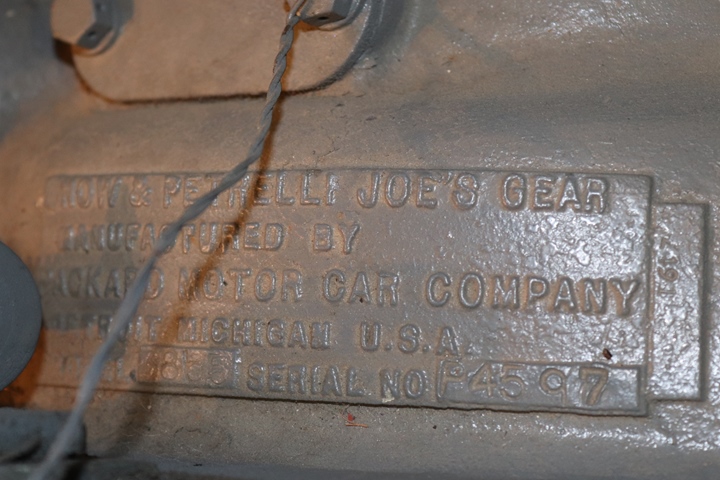
This example is one of two Packard-built
gear boxes attached to its marine engines that I have found. The
data plate shows that Packard was building the reversing gear box for
the 4M2500 being installed in the PT boats. The gear boxes may have been used in the
other applications like the rescue boats. Based on the serial
number, it appears Packard built at least 4,597 gear boxes.
Author's photo added 4-22-2020.
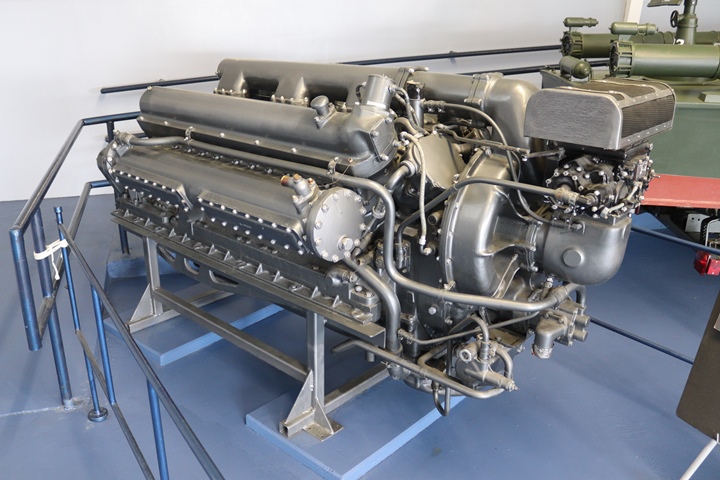
This very nicely restored Packard
4M2500 Marine Engine is on display at Battleship Cove Naval Museum.
It also has a Packard-built gear box installed on it. Author's photo added 2-16-2020.
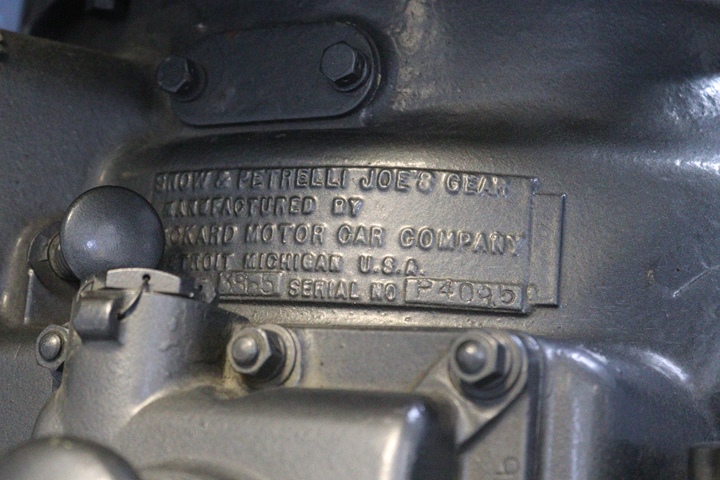
This one is serial number P4095. Author's photo added 2-16-2020.
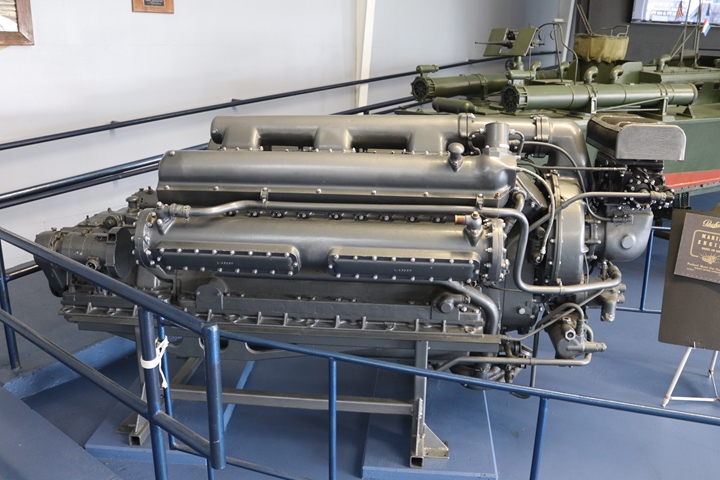
Author's photo added 2-16-2020.
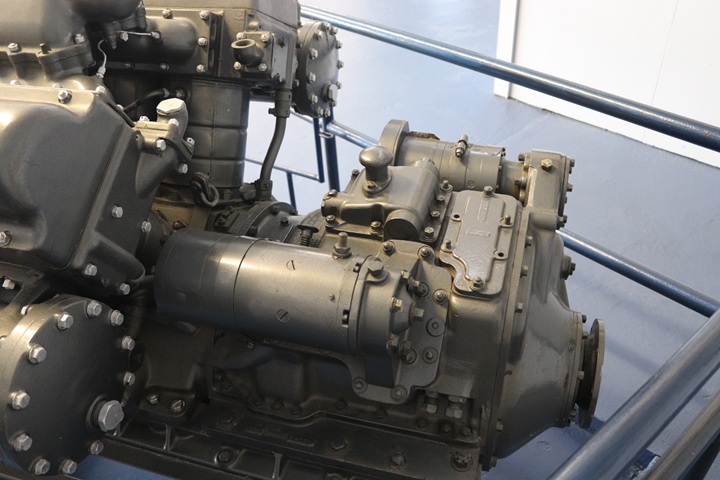
Author's photo added 2-16-2020.
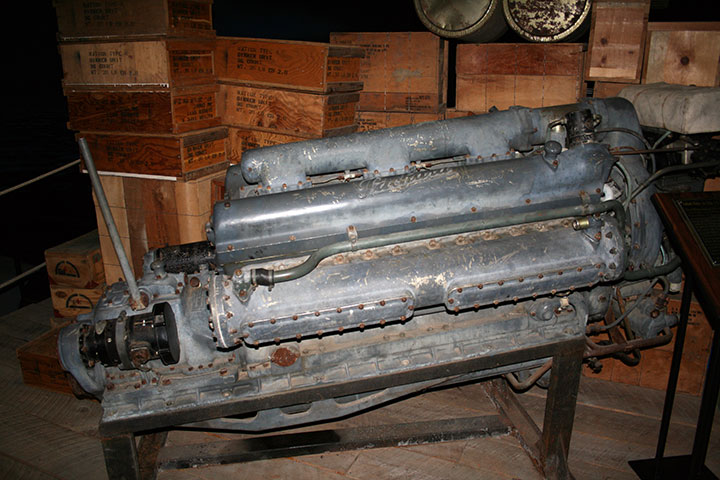
This un-restored Packard 4M2500 Marine Engine is
at the National Museum of the Pacific War in Fredericksburg, TX.
The lever at the left end of the engine is the reversing control.
Author's Photo.

The Packard Name on the valve cover. Author's Photo.
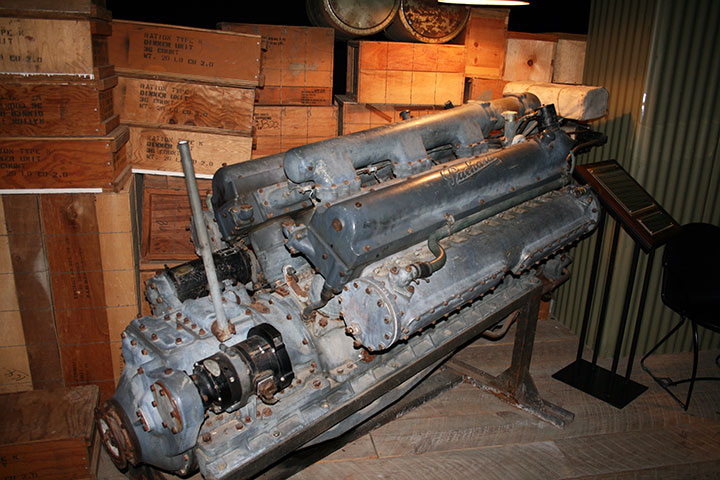
The
Delco-Remy Division of General Motors in Anderson, IN built the
generator and starter seen here for Packard Marine Engines.
Author's Photo.
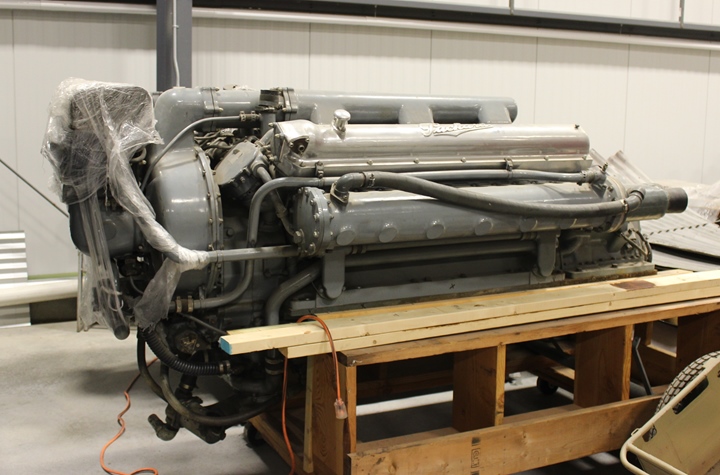
This 4M2500 is in storage at the Liberty
Aviation Museum and is being saved for a future Vosper motor torpedo
boat the museum is going to restore. Author's photo added 10-8-2015.
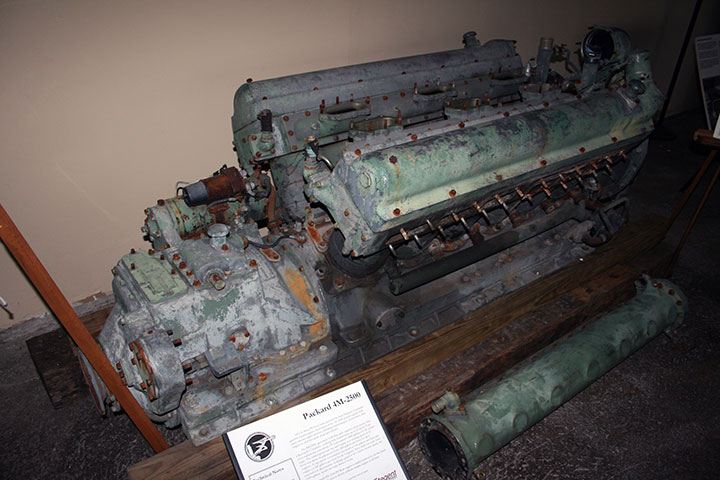
This Packard 4M2500 Marine Engine is at the
Packard Museum in Dayton, OH. Author's Photo.
|
Different Boat Types using the Packard 4M2500 Marine Engine |
|
Boat Type |
Number of Boats |
Engines per Boat |
Total Number of Engines |
Comments |
|
American-built Patrol Torpedo Boats (PT) |
741 |
3 |
2,223 |
506
went to the U.S., 146 to the U.K., and 93 to the U.S.S.R.
|
|
Canadian-built Patrol Torpedo Boats (PT) |
4 |
3 |
12 |
These
were for U.S. Navy. |
|
British-built Motor Torpedo Boats (MTB) |
44 |
3 |
132 |
|
|
British-built Motor Gun Boats (MGB) |
228 |
3 |
684 |
|
|
American-built Patrol 63-foot Crash Rescue Boats |
16 |
2 |
32 |
|
|
American-built Patrol 85-foot Rescue Boats |
140 |
2 |
280 |
|
|
American-built Patrol 104-foot Rescue Boats |
50 |
2 |
100 |
Estimated number. The 104-foot rescue boats were also
powered by Kermath and Hall-Scott engines. |
|
Totals |
1,224 |
|
3,463 |
|
|
The UK and Canada received 4,686
Packard engines during the war through either direct purchase or
Lend-Lease. With 12,700 total engines built, this
left 8,014 for spares for US and USSR applications in PT boats
and for OEM engines in the various rescue boats built for both
the Army Air Corps and the US Navy. |
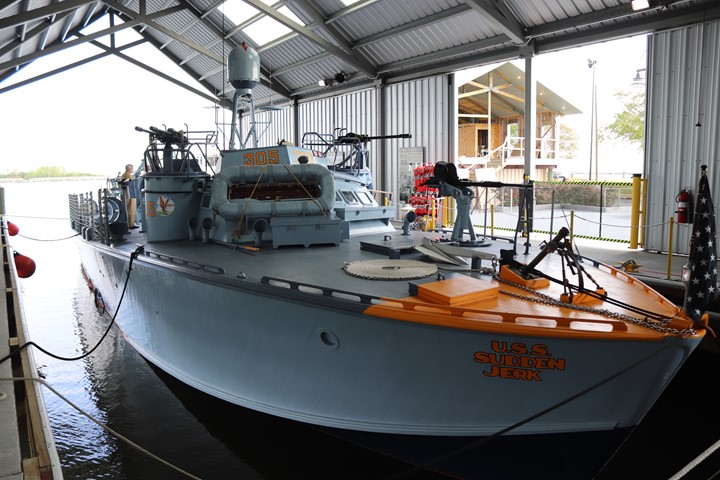
Higgins Industries built PT-305 at its boat house on Lake
Pontchartrain in New Orleans, LA. Author's photo added 1-16-2019.
PT-305 had its keel laid down on March 30, 1943, was launched on
May 27, 1943, and was completed December 8, 1943. On December 22,
1943, it was assigned to Motor Torpedo Boat Squadron 22, based at
Bastia, Corsica in the Mediterranean Theater of Operations. After
the invasion of southern France in August 1944, PT-305 moved to St.
Tropez, France. During her time in the
Mediterranean, she was credited with sinking five enemy vessels.
After the war ended in Europe, PT-305 returned to the United States for
deployment in the Pacific. When the war with Japan ended, she was
docked in New York. PT-305 was struck from the Naval Register on
November 25, 1945. On June 18,1948, PT-305 was transferred to the
War Assets Administration and was sold to the first of twelve private
owners through 2001. During that time period, the former PT-305
operated as a tour boat and a fishing vessel.
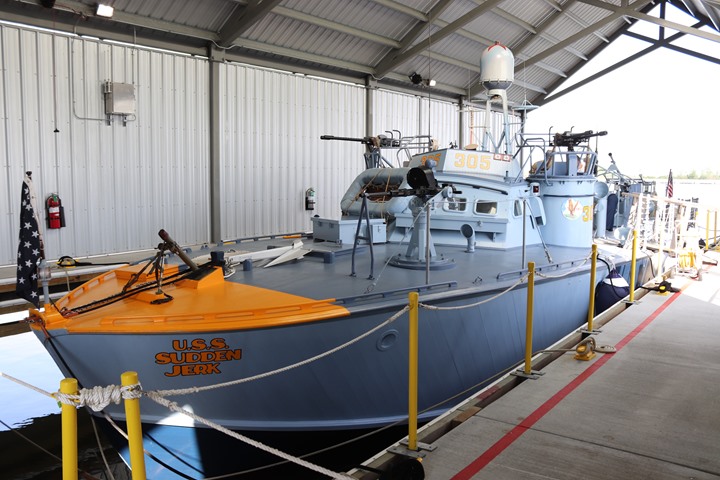
After 17,000 hours of work by
volunteers at the National Museum of World War Two in New Orleans,
PT-305 has been restored to her original World War Two configuration and
is the world's only Higgins-built combat veteran in operating condition.
Author's photo added 1-16-2019.
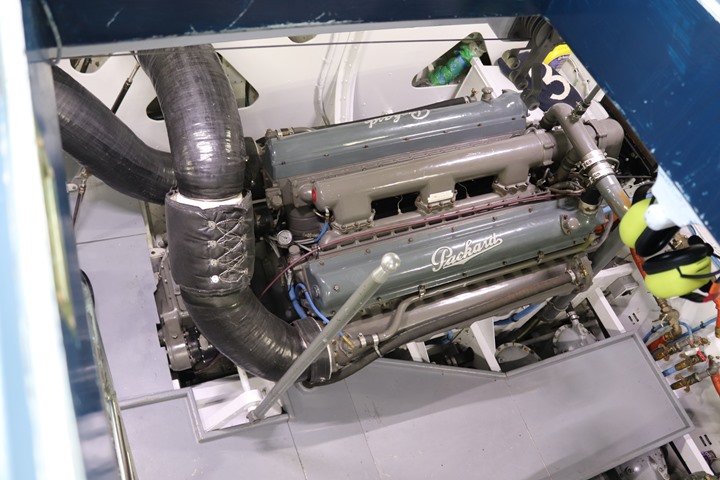
PT-305 has three rebuilt Packard 4M2500
engines in it. This is the port side engine. Author's photo added
1-16-2019.
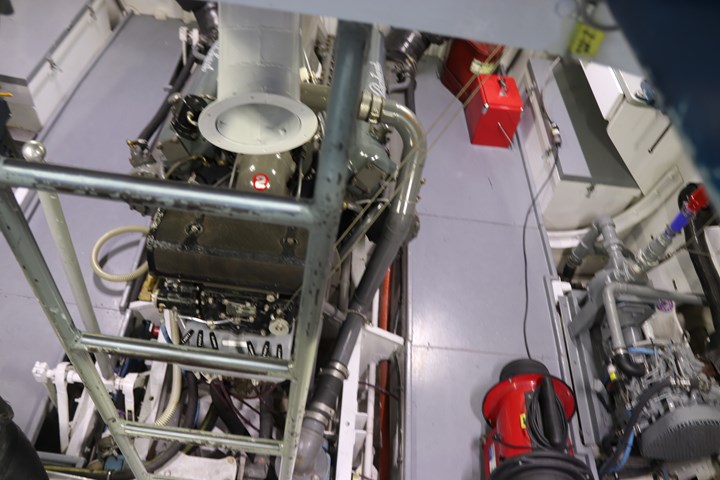
This is the middle 4M2500 engine in PT-305.
Author's photo added 1-16-2019.
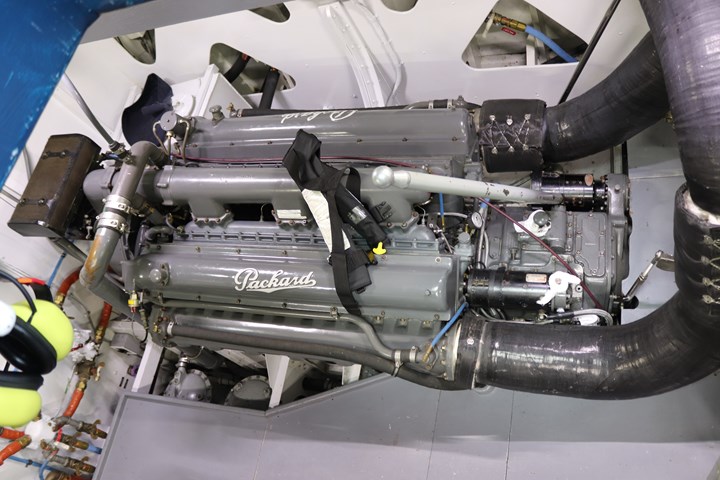
This is the starboard Packard-built
engine in PT-305. Author's photo added 1-16-2019.
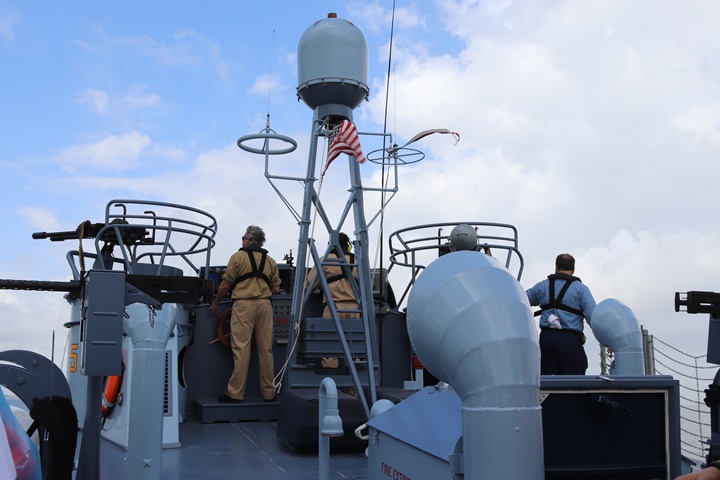
Cruising at 30 knots on Lake Pontchartrain.
This is the speed at which a Higgins PT boat rides best. Author's photo
added 1-16-2019.
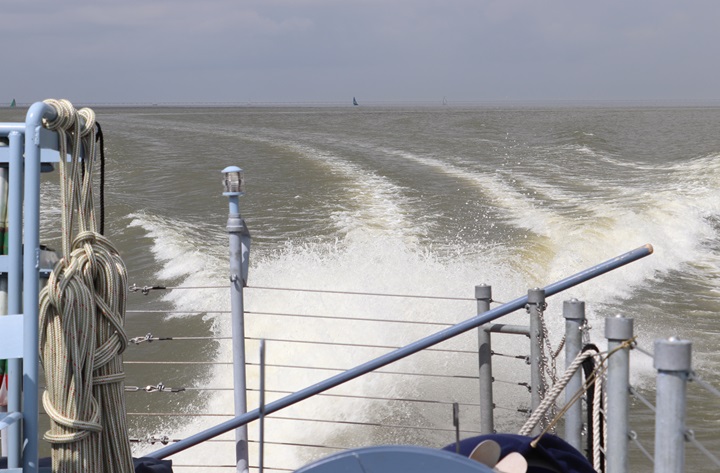
The 30 knot wake of PT-305 was made possible by
Packard 4M2500 engines. Author's photo added 1-16-2019.
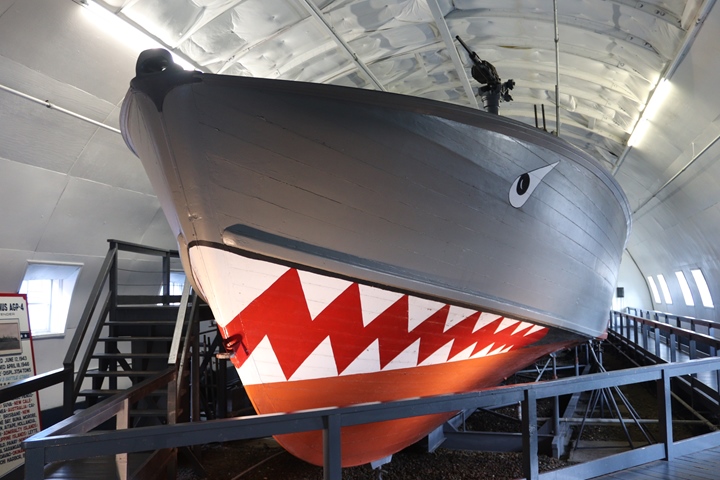
This is the bow of the Higgins-built PT-796
on display at Battleship Cove in Fall River, MA. One of the major
misconceptions of the World War Two PT Boat is that it was made out of
plywood, which is incorrect. In this photo and the one below the
planking used in the construction of the boats is plainly visible.
Author's photo added 2-16-2020.
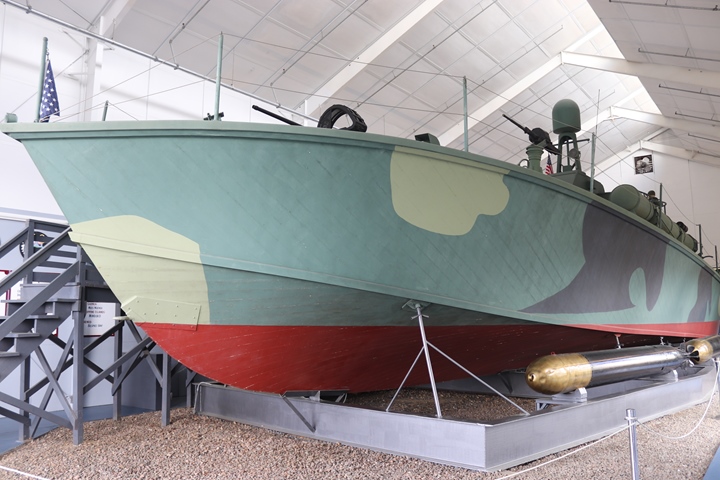
This is the bow of the Elco-built PT-617
also on display at Battleship Cove in Fall River, MA. This is the
only surviving Elco PT boat, and Battleship Cove is the only location
where both the Elco and Higgins PT boats can be seen together.
Author's photo added 2-16-2020.
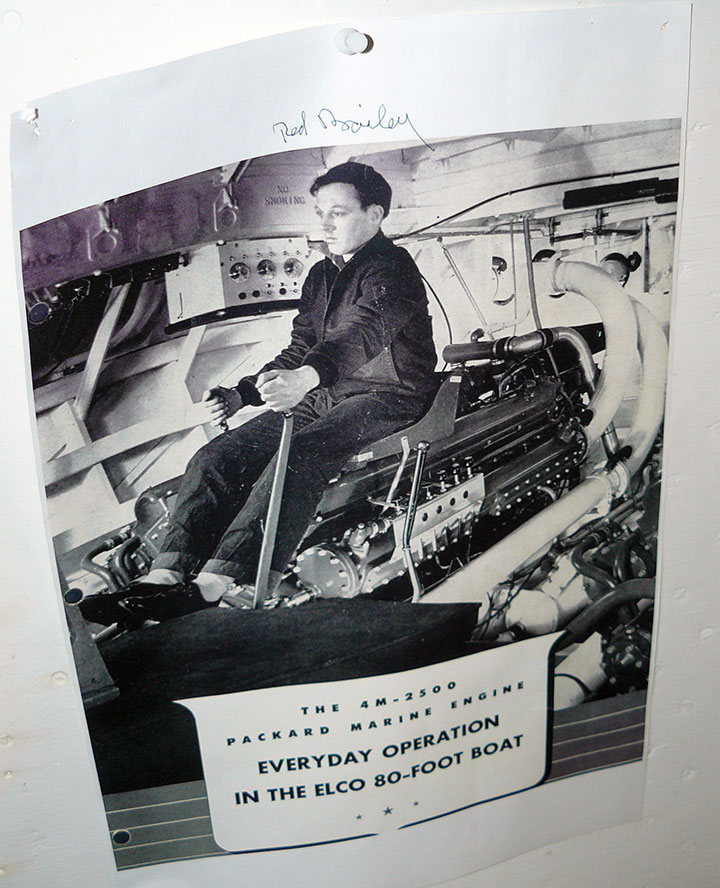
This photo shows how the crew members in the
engine room sat on a small seat on top of the engine to control the
direction of the PT boat. This had to be hot, noisy, and a
generally unpleasant activity. Bill Maloney Photo.
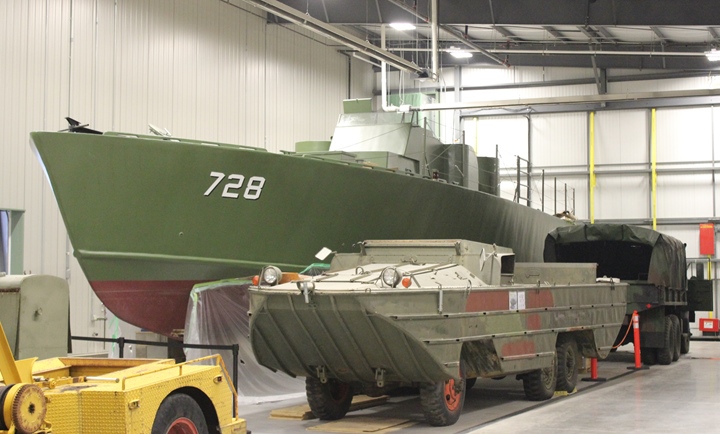
Pictured here is a 72-foot Vosper PT boat
built by the Annapolis Yacht Yard at Annapolis, MD in 1945 under license
from Vosper. It was intended for the USSR under Lead-Lease.
With the end of the war it was sold to a private owner in the US.
It was then purchased by the Liberty Aviation Museum in Port Clinton,
OH, which has been restoring it. When complete, PT-728 will be
available for giving paid rides to the public on Lake Erie.
However, due to US Coast Guard safety regulations, it will be diesel
powered. Author's photo added
10-8-2015.
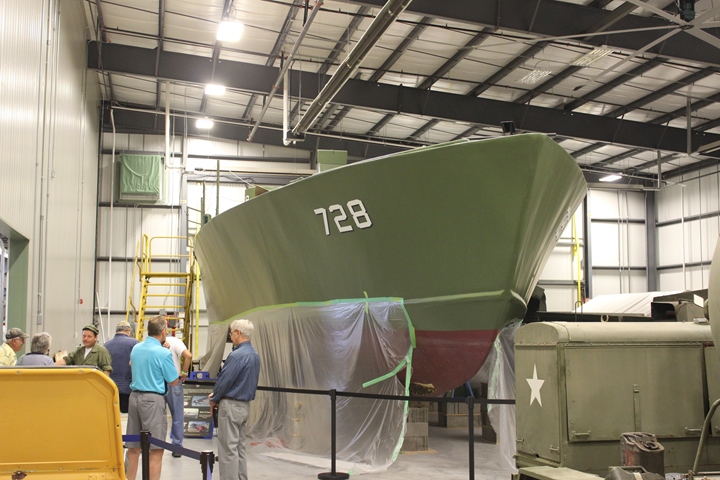
This photo shows the relative size compared
to the persons standing in front of it. When built it came with
Packard 4M-2500 engines just as all of the other 145 US built Vosper PT
boats did. Author's photo added 10-8-2015.
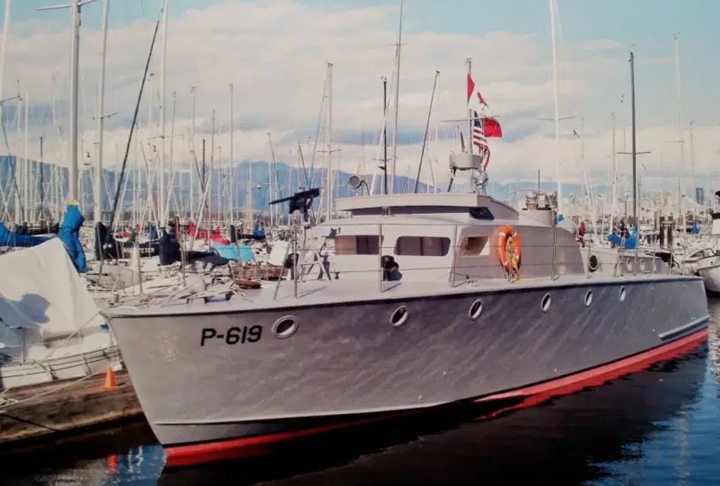
This
63-foot rescue boat built by the Miami Shipbuilding Company in December
1943 is now owned by Randy Cunningham of British Columbia. It is
powered by two Packard 4M2500 marine engines. Photo added
2-16-2020.
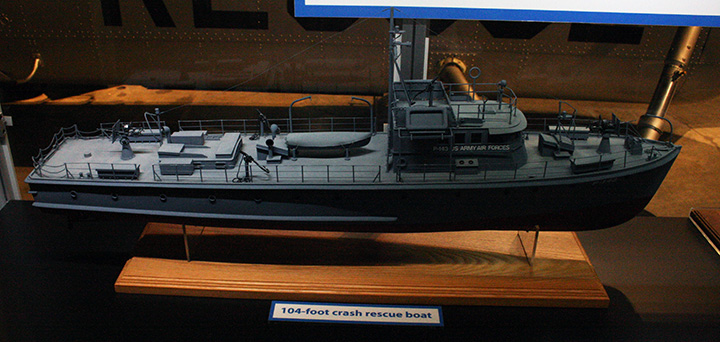
As noted above the Packard marine engine
also went into US Army Air Force Rescue boats that were used to rescue
downed aircrew in the ocean. Here is a model of a 104-foot Crash Rescue Boat as found at the
National Museum of the United States Air Force in Riverside, OH. Author's
photo.
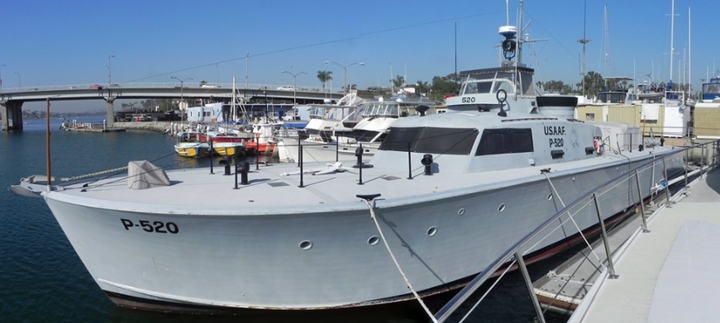
P-520 is an 85-foot Army Air Force rescue
boat. It was built in 1944 by the Wilmington Boat Works of
Wilmington, CA and is powered by two Packard 4M2500 marine engines.
Photo added 2-16-2020.
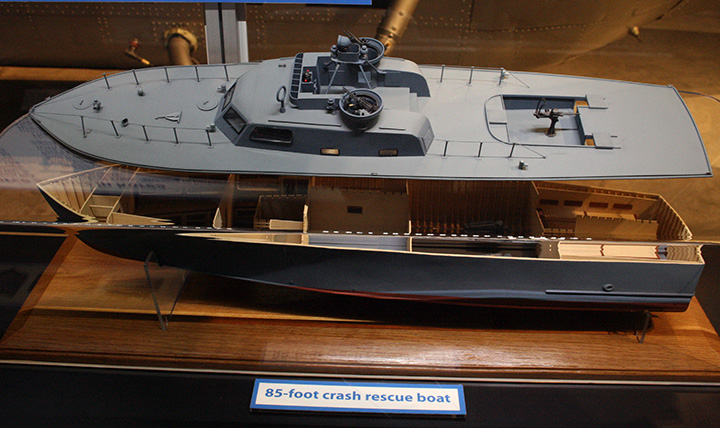
Here is an exploded view of the 85-foot
Crash Rescue Boat that was powered by two Packard marine engines.
Author's photo at the National Museum of the United States Air Force.
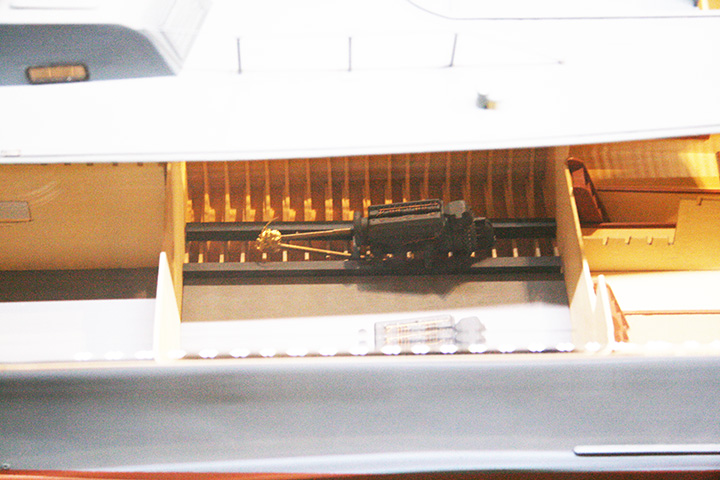
This photo of the model shows the engine
room with the drive shaft oriented towards the front of the boat and
then being directed towards the propeller at the stern through a
transfer case. There are two engines in the model boat, but my photo only
captured one. Author's photo at the National Museum of the United
States Air Force.
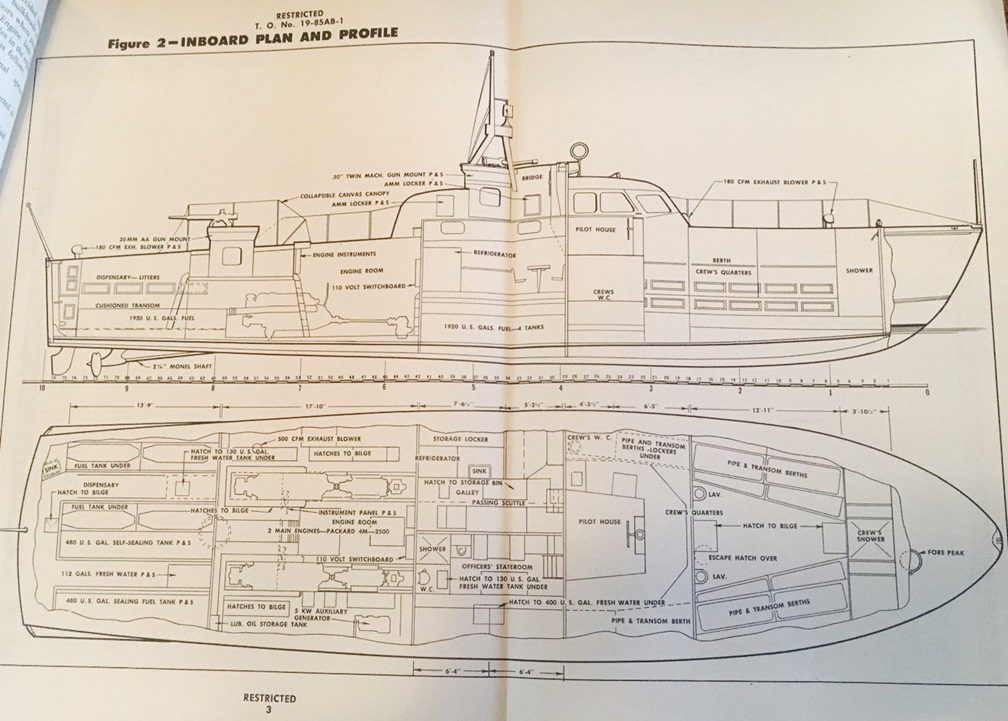
This engineering drawing gives two views of the 85-foot rescue boat.
The drawing shows two Packard 4M2500 engines facing forward with the
power directed to the rear via a transfer case. Drawing added
1-25-2020.
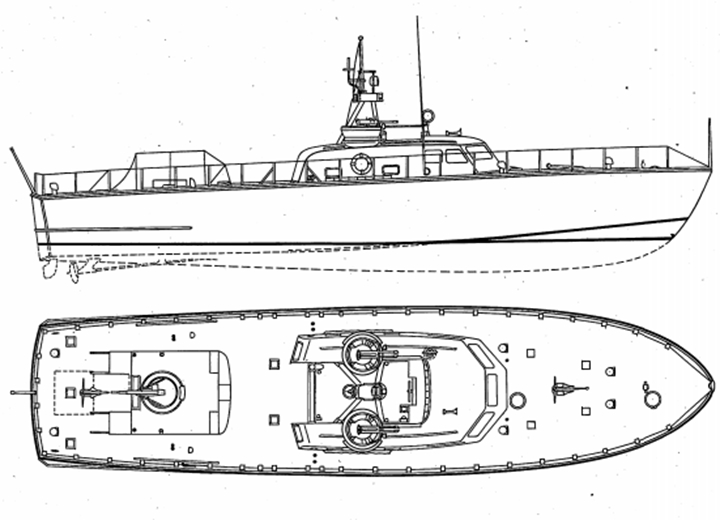
This drawing gives the outside profiles of
the 85-foot rescue boat. Drawing added 1-25-2020.
Packard World War Two Advertisements:
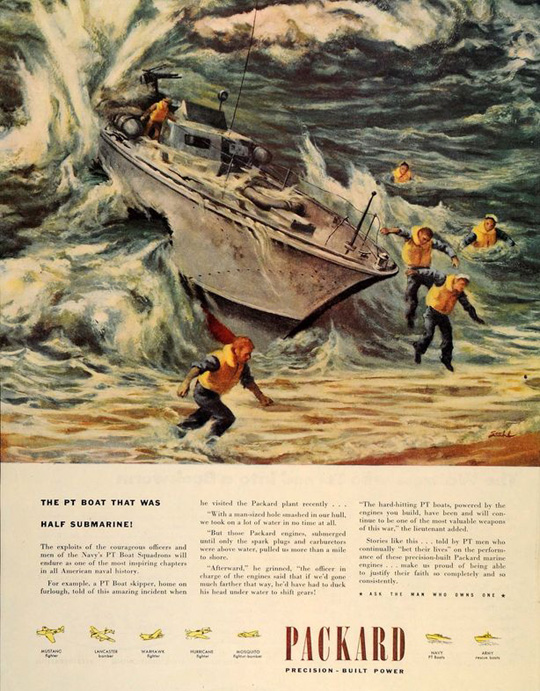
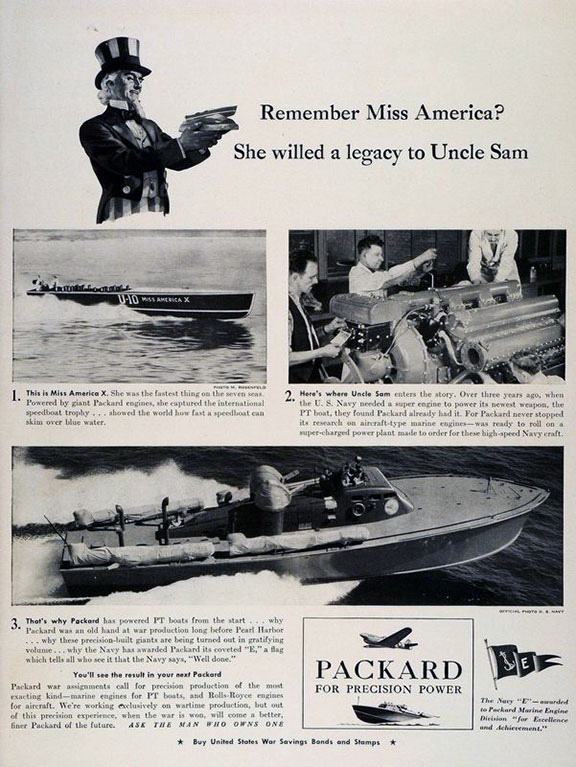
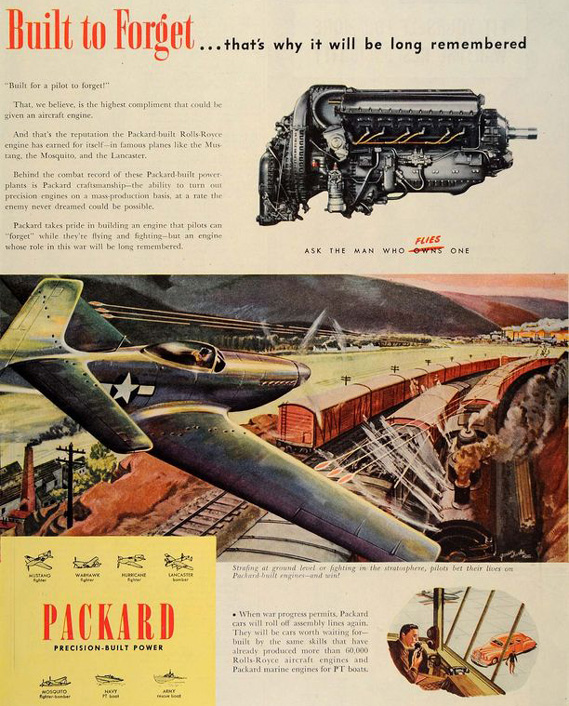
|
































































